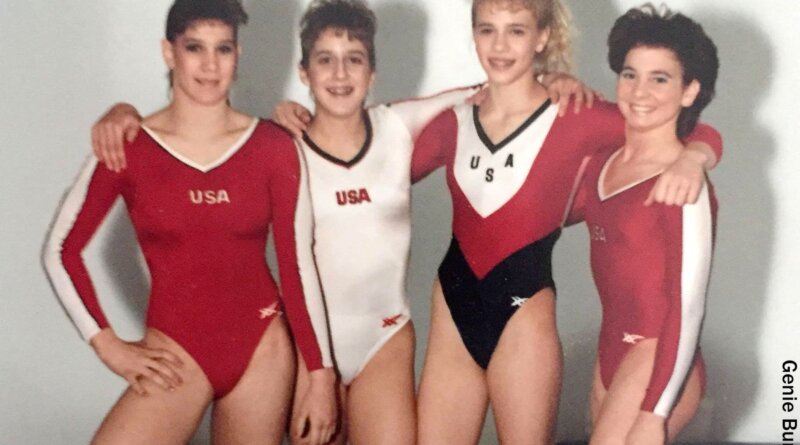Gymnast’s Death from Eating Disorder Still Resonates
June 1, 2022 — I’ll never forget that August night in 1994 when I sat down in my Atlanta apartment and turned on the TV after a long day of graduate school.
There was my gymnastics coach, Al Fong, talking with the Barbara Walters on TV about my ex- teammate Christy Henrich and her death by malnutrition/anorexia. I was floored at the conversation and the allegations that Al somehow, as her coach, was responsible for her eating disorder and subsequent death. I, too, had developed anorexia as a young teen, but I fortunately survived and thrived.
Christy was certainly our little “E.T. – Extra Tough.” We were the start of Al’s coaching career at the Great American Gymnastics Express in Blue Springs, MO. There were about 20 of us who started out with him in the late ’70s/early ’80s, and we were in the gym all the time: 6 days a week, 3-4 hours per day.
We were there during the hottest days, doing conditioning (cardiovascular hell), getting rips on our hands from bars, falling off the beam, getting bruises, shin splints, and wearing ourselves out. It was some of the hardest work I’ve ever done — and the most fun, rewarding time of my life. We traveled all across Missouri in that blue van. We fought, cried, and loved each other. We were a family, and Al was our metaphorical Dad.
Christy was several years younger than me and a much better gymnast than I was. I remember her being very sweet, cute … and tough minded. She was laser-focused on being a world-class Olympic gymnast. She missed making the 1988 Olympic team by 0.0188 points.
However, after this major accomplishment, she began to decline rapidly into the maddening world of eating disorders – using both anorexic and bulimic behaviors. Between the 1988 Olympic Trials and July 26, 1994, Christy lost weight, gymnastics, and her life.
A recent story in The New York Times about gymnastics, eating disorders, and mental health brought all of this back. The Times recounts much of Christy’s story and uses it as a introduction to the problems that have long-plagued women’s gymnastics.
I contacted our coach, Al Fong, about a week ago to get his perspective of what happened with Christy during her decline. He remembered that at an International meet in 1988 in Budapest prior to the Olympic trials, they had lunch with a well-renowned Olympic judge, Grete Treiber. Treiber told Christy, “You aren’t the right body fit for the Olympic team.”
Al said that at that moment, both he and Christy felt “devastated.” It was common during the 1980s and 1990s that gymnasts’ bodies were tall and lean as compared to the more muscular stature that we commonly see in Olympic gymnasts now. Because Christy had a muscular stature, she started making comments about the Romanian gymnasts’ bodies and how lean, strong, and muscular they were. Al said she admired them and frequently commented on how they walked, looked, and presented themselves. This, according to Al, started her descent. This is what I would call a “trigger.”
A year after the Olympics, Christy and Al went to the 1989 World Championships in Stuttgart, West Germany, where she finished fourth on uneven parallel bars. In reviewing the YouTube videos from that meet, she performed well and looked strong. However, Christy started losing weight consistently after this meet. Others told her how great she looked, and this was enough feedback to fuel the fire within.
Mental determination, focus, and grit: That’s what it takes to be a great, world-class gymnast. That’s what it also takes to become a very sick person with an eating disorder.
The article from The New York Times did a great job at highlighting some of the factors that are involved in competitive sports and eating disorders. This article used Christy’s story to talk about the perils of being in a sport that drives people to be perfect. It also talks about changes and growth in the industry so that athletes don’t have to die trying to win.
I want to provide some more education on why: Why do people who have such skill, talent, and determination develop such a deadly disease? It’s in the mix — there’s not one single factor that creates this “monster,” as Christy called it. Rather, it’s a combination:
- Biology: The statistics on mental health issues and biological connections are staggering.
- Mental drive: A core belief that “I must be perfect” or “I must succeed” is inherent in both issues. This is a key factor in developing and maintaining the drive to be a great athlete, and in an eating disorder, particularly anorexia.
- Pain: Whether the source of pain is ongoing or a one-time event, pain is inherent in our mental drive. This is by far one of the most powerful parts of being “extra tough.” Pain can come in the form of a physical, sexual, emotional, or verbal experience. It can be passive (being ignored) or active (“you are fat”) or violent (as in abuse). This is the key part in the development of the ”monster.”
The interplay between these three factors can make or break you. If you are in pain, have a faulty belief system (for example, believing a lie about yourself), and have the underlying biological ”stuff,” you will likely develop some sort of unhealthy relationship with something that you can misuse or abuse – whether that is a substance or a behavioral pattern. Regardless, these three elements can send you down a destructive path that will and can destroy your life.
As with Christy, she likely had a combination of these issues. Unfortunately, we will not know what they were. What we do know is that Al stopped training her because she was so ill and helped get her admitted into three different residential treatment centers for eating disorders. Unfortunately, Christy checked herself out of all three programs. He sought help from the best in the industry and tried desperately to get her treatment. She simply said no.
I was one of Al’s initial team members when he founded GAGE in 1978. My career apex was second all-around in Regionals (seven states). After I left the gym in May 1983, I developed anorexia and bulimia that November. It was not because of Al, gymnastics, or feeling “fat.” It was a combination of factors: Addiction runs in both sides of my family, my parents’ divorce, and not knowing how or what to do with that pain.
I had not one but multiple triggers, and the result was a 4-year battle with the thoughts, feelings, and behavior that “I was not good enough or lovable.”
After several decades of therapy, including a 6-week hospitalization in 1984, years of individual and group therapy, and an intensive 5-day program through the Caron Institute, I was free. I was free from the behaviors that consumed me, and this led me down the path of healing.
I later obtained a doctorate in psychology and founded a nonprofit program in 2006, the Manna Scholarship Fund. Manna provides scholarships for the treatment of eating disorders, as well as the underlying trauma that sustains eating disorders.
I have a team of amazing women that work hard to support the person with the eating disorder, the underlying trauma, as well as their families. We let our clients know that their ”stubbornness” is misdirected in the form of an eating disorder, and that they have a story to tell and a life to live abundantly.
An eating disorder doesn’t have to be a death sentence, although every 23 hours someone does die from an eating disorder. The earlier that you start the recovery journey, the easier it is to heal.
You are worth it. Your pain can be put into the past, and you can move forward and conquer whatever you want to do. Just do it.
Put your pain into a story and tell it. Write it. Scream it from the rooftops. Scream out your pain. Do whatever you need to do in order to move it from the inside of you to the outside of you.
This is where the healing is: in revealing, healing, and sealing the lid on the past. But you must do something. Today is a great day to start.
Genie Burnett, PsyD, is a licensed psychologist in Georgia. She is married and has four amazing fur babies.




